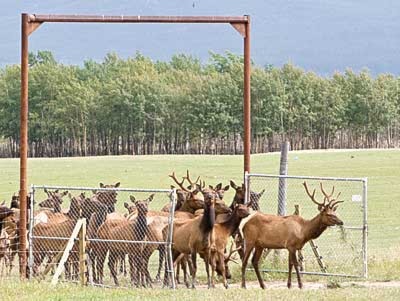More than 150 elk were released back into the wild on Thursday afternoon.
After spending five months in an enclosure at LaPrairie Bison Farm, about half of the elk tentatively wandered through the open gate, lured by a bale of hay.
The remainder of the herd slowly filtered out overnight.
Behind them they left regular meals, safety and thousands of pint-sized pests known as winter ticks.
The project has diminished tick infection in the herd by 80 per cent, said Rick Ward, an elk biologist with Environment Yukon.
The elk were herded into the pen in March in an effort to control the territory’s tick infestation.
Biologists discovered the problem last year, when they captured 20 elk for radio collaring.
Alarmingly, every single animal showed signs of tick infestation.
Environment has since been working to curb the infestation, fearing that the ticks may spread to other animals such as moose and caribou.
Moose, which are less able to groom themselves and therefore more susceptible to tick infestation, can be killed by the ticks through malnutrition and hair loss.
So far, the tick doesn’t seem to have spread to any other species.
Only one moose has ever been found with a tick infestation and that was 10 years ago.
After extensive studies, wildlife officials have reported that full eradication would be impossible.
The ticks are here to stay. Even killing the entire herd wouldn’t get rid of them.
Instead, biologists are endeavoring to limit the tick’s numbers by capturing about 120 elk and holding them until the ticks fall off naturally.
Ticks normally latch onto a host during the fall and stay with the animal until the spring or early summer, when the engorged ticks drop off to lay eggs.
Tick larvae then crawl up onto leaves and grass to wait for an animal to pass so as to repeat the cycle.
Wildlife officials simply had to wait until all the ticks had dropped off the animals before releasing the host elk back into the wild.
The enclosure is being sealed off; without the hosts the ticks will die over the winter.
Capturing the elk was one of many solutions originally proposed to deal with the tick infestation.
Wildlife officials also planned to cure the animals in the wild with feeding stations filled with medicated food.
However, this plan was nixed when elk refused to eat corn at the feed stations — even the un-medicated variety.
During Thursday’s media briefing, Ward laid out the steps that Environment will be taking toward tick control over the next 12 months.
Biologists would like to recapture as many animals of the Takhini herd as possible again next year, sometime between January and March.
This would help study the effectiveness of this year’s program and further reduce the number of ticks by again holding the elk until summer.
Wildlife officials will attempt to capture the Braeburn herd next year as well.
“We couldn’t capture them last year because the facilities just weren’t there and because of staff capacity,” said Ward.
Environment will have to build a facility in the Braeburn area to hold the elk — something that could cost up to $70,000.
Biologists will also continue to explore options for killing winter ticks on free-ranging elk.
There are plans to collaborate with universities to study winter tick ecology in the Yukon.
Based on these findings, experts will develop a long-term action plan for monitoring and dealing with the parasite.
In total, Environment is expecting to spend between $100,000 to $200,000 on tick control over the next year.
The winter tick first made its appearance in the territory in 1993, when additional elk were introduced to bolster dwindling populations.
Experts were aware that the elk carried the parasite, but believed that the tick couldn’t survive the Yukon’s frigid temperatures.
Unfortunately, the tick proved to be more tenacious than expected.
Elk were originally introduced in the 1950s to add some variety for the territory’s hunters.
However, elk have never flourished in the territory and populations have remained relatively stagnant — until now.
Because of the protection provided by the fenced enclosure at LaPrairie’s farm, the herd has 50 thriving calves.
